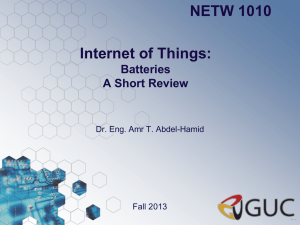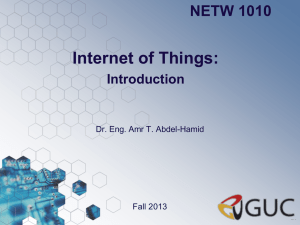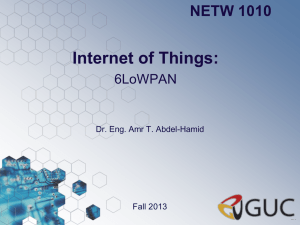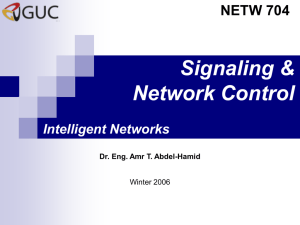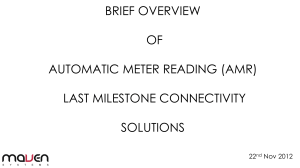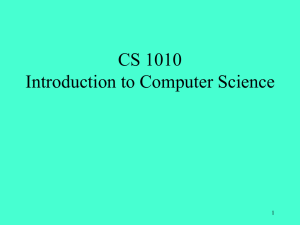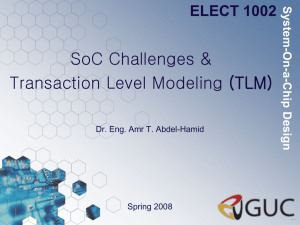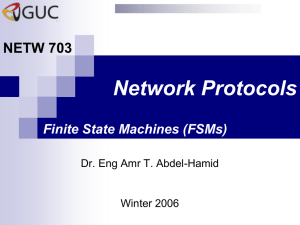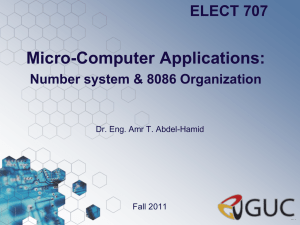Lecture 3
advertisement
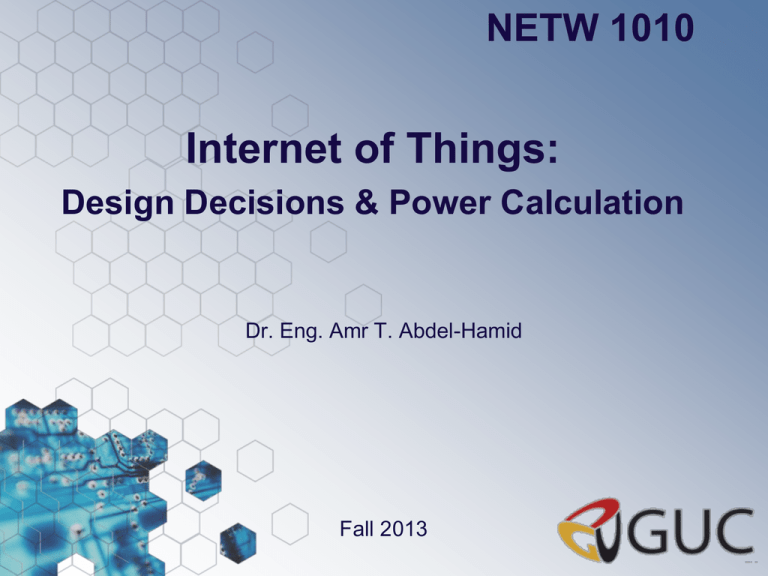
NETW 1010 Internet of Things: Design Decisions & Power Calculation Dr. Eng. Amr T. Abdel-Hamid Fall 2013 Power supply Internet of Things Energy is the most critical resource in a battery operated device (sensor node, “thing”) Energy supply has two tasks Provision of electrical energy Typically with batteries Conversion of other energy forms Extraction of energy from the environment Energy harvesting Dr. Amr Talaat NETW 1010 Energy consumption of sensor nodes Internet of Things Energy characteristic of the components Radio interface consumes the most energy Ratio of energy requirements of CPU / radio interface E(1 Instruction of CPU) : E(Sending of 1 bit) ≈1:1500 – 1:2900 Dr. Amr Talaat Send and receive operations are roughly equal expensive Best energy consumption reduction: switch-off radio Flash-Memory has high energy requirements Write operation ~900 times more expensive than read operati on Processor not so critical Typically several power modes available Sensors / Actors Varies between components and difficult to predict GPS is the WOREST NETW 1010 Hardware Node Internet of Things Dr. Amr Talaat NETW 1010 Energy Consumption Estimation in Embedded Systems Internet of Things Enode =Emicrocontroller+ESensor+ADC + Eradio Estimate the energy used per operation cycle Emicrocontroller = cp1.#instructions1-cycle+ cp2.#instructions2-cycles + cp3.#instruc tions3-cycles+ cp4.#instructions4-cycles + cp5.#instructions5-cycles Dr. Amr Talaat NETW 1010 Processor Energy Estimation Algorithm Internet of Things App. Source Code(C) Compilation Energy Info/History Dr. Amr Talaat Total Energy Estimated Energy Modeling Assembly Code Parsing and Profiling Profiling Results NETW 1010 Communication interfaces Internet of Things Dr. Amr Talaat Communication interface is required to exchang e data with other devices Typical communication media Radio Infrared (IR) Communication interface has high energy consu mption Radio interface consumes the most energy usual ly NETW 1010 ISM Frequencies Worldwide Internet of Things Dr. Amr Talaat NETW 1010 Low Power Modules Available Internet of Things Bluetooth low energy: Bluetooth® low energy (LE) star ted life as a project in the Nokia Research Centre with the name Wibree. (2.4 GHz) ANT: is a low-power proprietary wireless technology whic h operates in the 2.4 GHz spectrum ZigBee: is a low-power wireless specification based on IEE E Standard 802.15.4-2003 RF4CE: Radio Frequency for Consumer Electronics (RF4CE ) is based on ZigBee and was designed by four consumer electronics companies: Sony, Philips, Panasonic, and Sam sung. Dr. Amr Talaat NETW 1010 Low Power Modules Available Internet of Things Dr. Amr Talaat WiFi IRDA: Infrared Data Association (IrDA) has rec ently announced an ultra-high-speed connectivit y version, yielding 1 Gbps. However, it only wor ks over a distance of less than 10 cm. One of t he main problems with infrared (IR) is its line-of -sight requirement Nike+: is a proprietary wireless technology dev eloped by Nike and Apple to allow users to moni tor their activity levels while exercising. NETW 1010 Network topologies Internet of Things Dr. Amr Talaat Broadcast: A message is sent from a device in the hope t hat it is received by a receiver within range. The broadcas ter doesn't receive signals. Mesh: A message can be relayed from one point in a netw ork to any other by hopping through multiple nodes. Star: A central device can communicate with a number of connected devices — Bluetooth is a common example. Scanning: A scanning device is constantly in receive mod e, waiting to pick up a signal from anything transmitting w ithin range. Point-to-Point: In this mode, a one-to-one connection e xits, where only two devices are connected, similar to a ba sic phone call. NETW 1010 Supported Topologies Internet of Things LA A A+ Zi RF Wi Ni Ir Broadcast √ √ √ x x x x x Mesh √ √ √ √ √ x x x Star √ √ √ √ √ √ x x Scanning √ √ √ √ √ x √ x Point-toPoint √ √ √ √ √ √ √ √ Dr. Amr Talaat NETW 1010 Range Internet of Things IrDA – 10 cm Nike+ – 10 m ANT(+) – 30 m ZigBee – 100 m RF4CE based on ZigBee – 100 m Wi-Fi – 150 m LE – 280 m Dr. Amr Talaat NETW 1010 Throughput Internet of Things IrDA ~1 Gbps Wi-Fi (lowest power 802.11b mode) ~6 Mbps LE ~305 kbps ZigBee ~255 kbps RF4CE (same as ZigBee) ANT+ ~20 kbps Nike+ ~272 bps Dr. Amr Talaat NETW 1010 Latency Internet of Things ANT ~zero Wi-Fi ~1.5 ms LE ~2.5 ms ZigBee ~20 ms IrDA ~25 ms Nike+ ~1 second Dr. Amr Talaat NETW 1010 Power efficiency Internet of Things Power efficiency is often queried by customers who are int erested in prolonging the battery life of their devices while still achieving good user experience. (Amps./BIT) ANT An ANT device is configured to transmit 32 bytes/second a nd consumes 61 μA. A byte consists of 8 bits, therefore 32 x 8 = 256 bits/s econd Power = VI = 3 V x 61 μA = 0.183 mW Power per bit = 0.183 mW / 256 bits = 0.71 μW/bit Dr. Amr Talaat Always on, no sleep mode ?!!! NETW 1010 Power efficiency Internet of Things Bluetooth low energy Power consumption = 49 μA x 3 V = 0.147 mW Bytes per second = 20 x (1 second/500 ms) x 3 channe ls = 120 bytes/second Bits per second = 120 bytes/second x 8 = 960 bits/sec ond Power per bit = 0.147 mW/960 = 0.153 μW/bit Dr. Amr Talaat IrDA Power = 0.163 mW Bits = 14 Power per bit = 0.163 mW/14 bits = 11.7 μW/bit NETW 1010 Power efficiency Internet of Things Nike+ A foot pod lasts 1000 hours and transmits its payload every second. The payload is 34 bytes. A typical CR2032 has 225 mAh. Current drawn = 225 mAh/1000 hours = 0.225 mA Power = 3 x 0.225 mA = 0.675 mW Bits per second = 34 x 8 = 272 bits/second Power per bit = 0.675 mW / 272 = 2.48 μW/bit Dr. Amr Talaat NETW 1010 Power efficiency Internet of Things Wi-Fi Power = 116 mA x 1.8 V = 0.210 W Power per bit = 0.210/40,000,000 = 0.00525 μW/bit Zigbee A Zigbee device consumes 0.035706 W when transferring 2 4 bytes of data. Bits per second = 24 x 8 = 192 bits Power per bit = 0.035706/192 = 185.9 μW/bit Dr. Amr Talaat NETW 1010 Peak Power Consumption Internet of Things IrDA peak current draw ~ 10.2 mA Nike+ peak current draw ~ 12.3 mA LE peak current draw ~ 12.5 mA ANT peak current draw ~ 17 mA RF4CE and Zigbee peak current draw ~ 40 mA Wi-Fi peak current draw ~ 116 mA Dr. Amr Talaat NETW 1010 Eradio Calculations Internet of Things Eradio = (P(per Bit)* Number of Bits)+ (I sleep* V * T) Total Energy used for this module What kind of a battery needed then?! Dr. Amr Talaat NETW 1010
